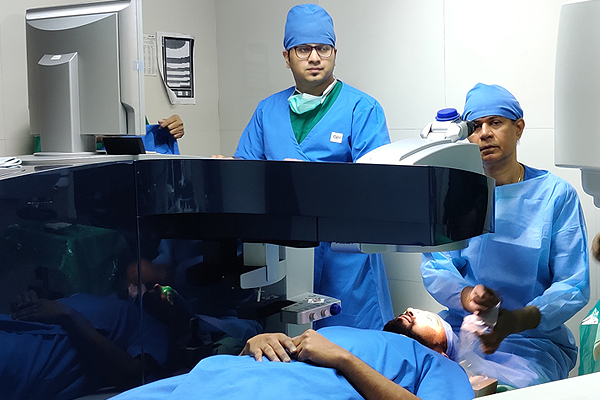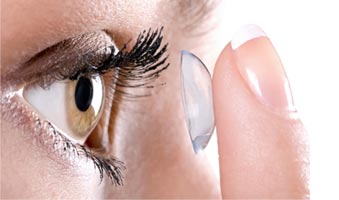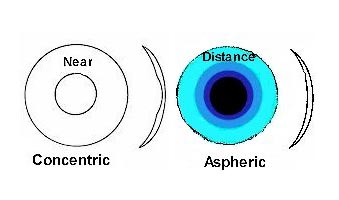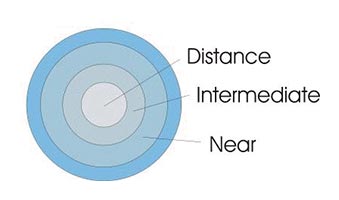

Soft contact lenses are made of a soft polymer-plastic material combined with a percentage of water. Water allows oxygen to pass through the contact lens material and increases comfort. Many soft contact lenses also provide UV protection. Soft contact lenses are more comfortable than rigid gas permeable contact lenses when first inserted into the eye.
You can get disposable soft contact lenses – which reduce the chances of infection and involve little or no cleaning and offer much greater comfort. The disposable contact lenses also solve the problem of protein deposition as they are not used for a prolonged period of time. The one disadvantage of soft contact lenses is that it is far easier for these lenses to pick up pollutants such as soapy water. This can cause irritation to your eye.
Daily Disposables – These are used for a day and then disposed. These are convenient as there is no need to clean them and they do not allow protein deposition. It eliminates dry eye and irritation caused due to allergy to contact lens solutions.
Silicone Extended Wear Disposables – These soft contact lenses are made with a new “silicone hydrogel” material and can be worn for up to 30 nights and days. The material prevents protein deposit build up and lessens dry eye irritation.
Coloured contact lenses are a cosmetic application that can offer you a change in personality or appearance. There are four types of colored contact lenses, each offering a slightly different benefit:
Visibility tint – These contact lenses are lightly tinted, so you can find your lens if you drop it. Visibility tints don’t change the color of your eyes.
Enhancement tint – These colored contact lenses have a translucent tint that’s meant to enhance your natural eye color. Enhancement tints are slightly darker than a visibility tint.
Color tint – These contact lenses have a darker, opaque tints that change the color of your eyes. Color tints come in a wide array of specialty colors, including amethyst, violet, and green.

Light-filtering tint – These colored contact lenses are designed for athletes and sports fans. They enhance certain colors and diminish other colors. For instance, contact lenses for tennis players would enhance optic yellow, the color of tennis balls.
Colored contact lenses are a medical device just like clear contact lenses, even though its application in some cases many be cosmetic. Do not share colored contacts lenses. You need to clean and maintain them just as you would any prescription contact lens.
Soft Toric lenses have twin power that is possible due to the different curvatures at different angles (one for astigmatism, the other for either myopia or hyperopia). Some soft toric lenses also have a mechanism to keep the contact lens relatively stable on the eye. This prevents movement of the lenses when you blink or look around. Stability of the toric contact lenses is necessary for steady vision.
Bifocal and multifocal contact lenses work in several different ways, depending on the design and construction of the lens.


Your eye doctor is the right person to recommend a suitable lens. The choice will depend on your “add” prescription power and your pupil size. But remember, the suitability of the lense and your comfort level cannot be predicted and you might have to try the different types before you settle on one that suits you best.
Most people know about the soft gas permeable contact lenses, but very few are aware of the Rigid Gas Permeable lenses. These lenses are not to be confused with the old ‘hard” contact lenses. Those were made of a rigid material called PMMA. This material was hard to adjust to and did not permit passage of oxygen.
Rigid Gas Permeable contact lenses actually use more advanced technology than soft lenses. These lenses are made from silicone which allows oxygen to pass through.
Description – The Fluid Ventilated gas permeable Scleral lenses are a vital component in the management of severe ocular surface disease. Its use results in reducing greatly the disabling ocular pain and photophobia. The main therapeutic benefit of the Scleral lens is provided by the oxygenated aqueous environment they create of the surface of the corneal epithelium. This forms a kind of a barrier that protects the epithelial surface from the impact of exposure to air and the friction caused by blinking and the blink induced movement of the contact lens
Distinction – Since it avoids all corneal contact while covering irregular astigmatism, the Boston Scleral Lens can rehabilitate vision in eyes that have a variety of corneal disorders, many of which are intolerant to the traditional rigid gas-permeable (RGP) contact lenses.
Suitability – The following is a partial list of indications for which the Boston Scelral lens may be indicated if spectacles are inadequate in vision correction and the eyes of the patient are intolerant of normal corneal contact lenses.
Description – Rose K Lenses are considered a quantum leap forward in the evolution of lens design for patients suffering from keratoconus. It is today the world’s most frequently prescribed rigid gas permeable contact lens for keratoconus.
Distinction – The complex geometry can be customized to suit each eye and can correct all of the myopia and astigmatism associated with Keratoconus. It is also commonly used for correction of post-keratoplasty astigmatism improving the vision after corneal transplantation.
Suitability – The complex geometry of every Rose K™ contact lens closely mimics the cone like shape of the cornea, for every stage of the keratoconus condition. This results in a comfortable lens fitting and improved sight for patients.
Copyright © 1987-2024 Ojas Eye Hospital All rights reserved | Privacy Policy
*Disclaimer: All information on www.lasikindia.com for informational purposes only and is not intended to be a substitute for professional medical advice, diagnosis, or treatment. Always seek the advice of your physician or other qualified health care provider.